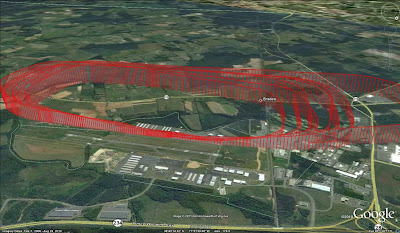I busted the flight portion of my FAA Private Pilot practical test (checkride) today. I must make it clear that this was entirely my fault, and the examiner was beyond fair. I'll admit, it really took the piss out of me this afternoon. I was surprised at just how lousy I felt for a few hours to follow. The examiner walked back to the FBO while I was putting the airplane away. News spreads fast, and it was embarrassing walking in there a few minutes later. So it goes.
The oral exam was no problem. I was prepared. I had that stuff down cold. He nailed me on a long-held misconception, though: assume there is a strong crosswind component for a particular runway and you are flying the downwind leg of the traffic pattern. You turn base. That crosswind now becomes a tailwind. I thought that the
indicated airspeed would drop--ever so briefly--while the airplane accelerated in the now-changed relative wind. Wrong. He seemed to have some fun with that, and it dragged out until I finally gave up and said, "I'm wrong." I figured that this new tailwind would be like flying through a dying gust, and in that case, the indicated airspeed does briefly drop--I've seen it. This is a prime example why you should keep your explanations to the barest minimum lest you unnecessarily expose your ignorance on something. The DPE will assuredly hammer you.
Shortly thereafter, the examiner declared that I had passed the oral portion of the exam. I said that I wanted to look at the weather to decide whether or not to fly. The latest METARs at the time showed the gusts were gone and the turbulence AIRMET was no longer covering the flight area:
KHEF 231815Z AUTO 32013KT 10SM CLR M01/M16 A3016 RMK AO1
I solicited a few PIREPs from returning pilots, and the reports were favorable. The winds aloft (3000 feet) were forecasted to be light. I decided to go for it, since I judged the current conditions to be within my capabilities. I soon discovered that the surface winds didn't stay that way for long, though. Here were the METARs during my flight:
KHEF 231915Z AUTO 33013G19KT 10SM CLR M01/M17 A3017 RMK AO1
KHEF 231935Z AUTO 31018G22KT 10SM CLR M01/M16 A3017 RMK AO1
KHEF 231955Z AUTO 31010G23KT 10SM CLR M01/M17 A3018 RMK AO1
KCJR 231920Z AUTO 35008G15KT 10SM CLR 01/M13 A3015 RMK AO2
Fortunately, the wind was almost right down the runway at HEF. During the run-up, I thought the mag drop might be a little high, so I did it again to confirm. I managed in that attempt to somehow turn the ignition switch to OFF instead of the right mag. This caused the engine to backfire. I've never done that before. It set the tone for the flight. The chief instructor gave me a lecture about that on my return. Apparently you can blow off the muffler that way. Won't happen again.
After a marginally passable soft-field takeoff, I contacted Potomac departure and began to intercept my course. My wind correction calculation and the forecasted winds aloft were good, so I intercepted my course and flew the first two checkpoints without requiring much additional correction.
 |
| Botched emergency approach |
At 2500 ft. MSL, he asked me to pull carb heat and close the throttle to simulate an engine failure. It was made clear that this was do-or-die: I was to put the airplane safely on the grass strip below, or I would fail the test. I've done this maneuver successfully several times in the past. I set up to fly the downwind leg and spiraled down. I was too close, laterally, to the runway below. I was shooting to be at 1,200 feet at the key point on downwind, where I would begin to fly a pattern for the dead-stick approach. One problem was that I didn't line up for the downwind--I wasn't where I needed to be. I was in mid-spiral and I didn't think I could make another turn before falling below my target altitude, so I started flying toward the runway way too high. I was worried about the strong headwind causing me to land short, and in my confusion, I didn't get flaps in fast enough and my forward slip was anemic. This made the examiner clearly very unhappy (they really don't enjoy failing applicants).
I hadn't been told that the test was a bust, so I was still flying, but it was difficult to get my head back in the game. The rest of the flight was a blur of utterly embarrassing airmanship. He declared that more training was required on my part at one point, and I took us back to HEF. I was to do a soft-field landing. This was horribly executed.
In the end, I have to retest the emergency maneuvers and soft field landings. I believe that was beyond generous. So here is a weird loophole in the FARs: I log pilot-in-command time with a passenger, even though I remain a student pilot. It is otherwise illegal to fly passengers as a student pilot.
The failed emergency approaches demonstrated that I do not yet have the proficiency to perform the maneuvers when loaded up with stress (and believe me, this was a stressful event). A real emergency will certainly be stressful, and I don't want these privileges unless I'm sure that I can use them safely even if an engine failure should occur. I am undeterred, however. I'll practice with my CFI and try again soon. I enjoy flying too much and I have worked too hard to back away now.
Flight time today:
1.4 hrs PIC











